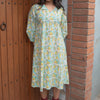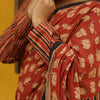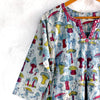Key Influences on Chanderi Saree Design
- by Divyesh Patel
Chanderi saree design is intricately woven with influences like Mughal architecture, Hindu mythology, and regional artistic traditions, creating a rich tapestry of cultural symbolism and historical narratives. Traditional motifs such as Ashrafi Buti and Nalferma carry deep cultural significance, reflecting centuries-old traditions and artistic influences. Royal patronage has elevated Chanderi sarees, blending modern trends with traditional craftsmanship techniques. Nature-inspired designs, sustainable practices, and minimalist elegance are key trends shaping Chanderi saree aesthetics. Global influences and cross-cultural creativity continue to evolve Chanderi saree design, creating a fusion of traditional and modern elements.
Historical Inspirations
Drawing from centuries of tradition, our exploration of the historical inspirations behind Chanderi saree design reveals a rich tapestry of cultural influences that have shaped this iconic garment. The intricate patterns and motifs found in Chanderi sarees often draw inspiration from Mughal architecture, with delicate floral designs and geometric patterns reminiscent of the grandeur seen in Mughal palaces and forts. These elements not only add a touch of elegance but also reflect a harmonious blend of artistic styles from different eras.

Furthermore, Hindu mythology plays a significant role in influencing Chanderi saree design. Depictions of gods, goddesses, and mythical creatures can be found intricately woven into the fabric, symbolizing cultural beliefs and traditions. The use of vibrant colors and symbolic motifs adds a mystical allure to the sarees, making them more than just garments but also embodiments of ancient stories and cultural heritage. Through these historical inspirations, Chanderi sarees continue to captivate wearers with their timeless beauty and cultural significance.
Cultural Symbolism
In exploring the cultural symbolism inherent in Chanderi saree design, one cannot ignore the deep-rooted significance of intricate motifs and patterns that carry layers of historical narratives and traditional beliefs. Symbolism in Chanderi sarees goes beyond mere decorative elements; each motif holds a story, a tradition, and a belief system that has been passed down through generations. The interplay of colors, the arrangement of patterns, and the choice of motifs all contribute to the cultural significance of Chanderi sarees.
Traditional motifs like the Ashrafi Buti, Nalferma, and Dandidar are not just designs on fabric but carriers of cultural heritage and design inspiration. The Ashrafi Buti symbolizes wealth and prosperity, while the Nalferma motif represents the beauty and delicacy of nature. These motifs are not randomly chosen but are deeply rooted in the cultural ethos of Chanderi, reflecting the values and beliefs of the community.
Understanding the cultural symbolism in Chanderi sarees adds a layer of richness and depth to the appreciation of these exquisite garments, making each drape a canvas of tradition and stories waiting to be unveiled.
Regional Artistic Traditions
As we explore the intricate world of Chanderi saree design, we uncover the rich tapestry of regional artistic traditions that have shaped this exquisite craft. The cultural design influences evident in every weave tell a story of heritage and artistry passed down through generations. The seamless integration of artisan techniques highlights the meticulous craftsmanship and attention to detail that define Chanderi sarees as a true work of art.
Cultural Design Influences
Regional artistic traditions play a pivotal role in shaping the intricate and distinct design elements found in Chanderi sarees. The traditional motifs prevalent in Chanderi sarees are often inspired by the rich cultural heritage of India, reflecting the flora, fauna, and geometric patterns that have been passed down through generations. These motifs are meticulously incorporated into the fabric, showcasing the craftsmanship and attention to detail that is characteristic of Chanderi sarees.
The color palette of Chanderi sarees is also deeply influenced by regional artistic traditions. Earthy tones like mustard yellow, deep red, and forest green are commonly used, mirroring the natural landscapes and vibrant festivals of the region. These colors not only evoke a sense of tradition but also add a timeless elegance to the sarees. The combination of these traditional motifs and colors results in Chanderi sarees that are not only visually stunning but also culturally significant, representing a harmonious blend of heritage and artistry.
Artisan Techniques Integration
Drawing from centuries-old techniques, artisans infuse their expertise into the creation of Chanderi sarees, seamlessly integrating regional artistic traditions into every intricate detail. Handloom craftsmanship lies at the heart of Chanderi saree production, with weavers meticulously hand-weaving these delicate fabrics. The innovative weaving methods employed by these artisans result in the sheer texture and luxurious feel that Chanderi sarees are renowned for.

Traditional motifs play a significant role in Chanderi saree design, with motifs like peacocks, geometric patterns, and floral designs being common in these sarees. However, artisans also showcase their creativity by incorporating modern adaptations of these traditional motifs, adding a contemporary touch to the classic Chanderi saree. This fusion of traditional and modern elements not only keeps the saree relevant in today’s fashion landscape but also pays homage to the rich heritage of Chanderi weaving.
The integration of regional artistic traditions in Chanderi saree design highlights the skill and artistry of the artisans, making each saree a masterpiece that reflects the cultural richness of the region.
Royal Patronage
With a rich history dating back centuries, the Chanderi saree design has been favored by royalty for its exquisite craftsmanship and luxurious appeal. The patronage of royal families not only elevated the status of Chanderi sarees but also had a significant economic impact on the weavers and artisans involved in their creation. Traditional craftsmanship techniques were honed and perfected under the watchful eye of royal patrons, leading to the development of intricate designs and superior quality fabrics.
Revival projects and preservation efforts have played a vital role in maintaining the essence of Chanderi sarees as favored by royalty. These initiatives have ensured that the heritage and artistry of Chanderi saree design are not lost to time, allowing future generations to continue appreciating its beauty and cultural significance. The support of royal families in these revival projects has been instrumental in keeping the legacy of Chanderi sarees alive and thriving.
Modern Fashion Trends
As we explore modern fashion trends in Chanderi sarees, we observe a fascinating interplay of current style influences and contemporary design elements. These sarees are not only rooted in tradition but also embrace innovation, adapting to the evolving tastes of the fashion world. The fusion of timeless craftsmanship with modern aesthetics creates a unique tapestry of elegance and sophistication in Chanderi saree design.
Current Style Influences
Incorporating contemporary elements such as geometric patterns and bold color combinations, modern fashion trends have significantly influenced the design of Chanderi sarees in recent years. Celebrity endorsements play a pivotal role in shaping these influences, as prominent figures showcase Chanderi sarees in various styles, attracting a wider audience and setting new trends. Social media platforms have also become instrumental in spreading these modern influences, with fashion influencers and bloggers showcasing innovative ways to style Chanderi sarees, further fueling their popularity.

The fusion of traditional Chanderi craftsmanship with modern design elements has resulted in a fresh and dynamic interpretation of this timeless garment. Designers are now experimenting with asymmetrical hemlines, contemporary blouse designs, and unconventional draping styles, appealing to younger generations while retaining the saree’s classic elegance. By embracing current style influences, Chanderi sarees continue to evolve and adapt to the ever-changing landscape of fashion, ensuring their relevance in today’s modern world.
Contemporary Design Elements
Modern fashion trends have redefined the design landscape of Chanderi sarees by infusing contemporary elements such as geometric patterns and bold color combinations. The fusion of traditional Chanderi craftsmanship with modern aesthetics has given rise to a new wave of saree designs that embrace minimalist elegance while incorporating bold and innovative features. Geometric patterns, once rare in Chanderi sarees, are now making a striking appearance, adding a modern touch to the timeless fabric. Bold color choices, from vibrant neons to deep jewel tones, are becoming increasingly popular, appealing to a younger audience while still honoring the saree’s rich heritage.
- Minimalist elegance: The shift towards simplicity and understated sophistication.
- Fusion styles: Blending traditional Chanderi techniques with contemporary design elements.
- Geometric patterns: Adding a modern and structured look to the saree.
- Bold color choices: Experimenting with vibrant and unconventional colors.
- Innovative textures: Incorporating new textures and fabrics for a fresh twist on traditional Chanderi sarees.
Textile Techniques
Utilizing traditional weaving methods and intricate hand embroidery, textile techniques play a crucial role in the intricate artistry of Chanderi saree design. The weaving patterns in Chanderi sarees are crafted with precision, showcasing delicate motifs like peacocks, flowers, and geometric shapes. These patterns are meticulously woven into the fabric, creating a mesmerizing interplay of design and texture.

Furthermore, dyeing techniques are another essential aspect of Chanderi saree production. Artisans use natural dyes derived from plants and minerals to achieve a rich color palette that is both vibrant and long-lasting. The process of dyeing involves careful attention to detail, ensuring that the colors penetrate the fabric evenly, resulting in a flawless finish.
In Chanderi sarees, the combination of intricate weaving patterns and vibrant dyeing techniques culminates in exquisite pieces that are both timeless and elegant. The craftsmanship involved in these textile techniques reflects the rich cultural heritage and skilled artistry that define Chanderi saree design.
Nature and Environment
Our appreciation for the exquisite art of Chanderi saree design is intricately intertwined with the natural elements and environmental considerations that shape the production process. The serene beauty of Chanderi sarees is not just a visual delight but also a reflection of our commitment to sustainability and harmony with nature.
- Floral motifs: The delicate floral motifs adorning Chanderi sarees are inspired by the vibrant flora of the region, adding a touch of organic elegance to the fabric.
- Natural colors: The dyes used in Chanderi saree production are often derived from natural sources like flowers, leaves, and roots, ensuring a rich color palette that is eco-friendly.
- Hand-weaving tradition: The traditional hand-weaving techniques employed in Chanderi saree making not only preserve artisanal skills but also reduce the carbon footprint associated with machine production.
- Local craftsmanship: The skilled artisans who craft Chanderi sarees are deeply connected to the land, drawing inspiration from the surrounding natural beauty to create timeless pieces.
- Environmental impact: By prioritizing natural materials and traditional techniques, Chanderi saree production minimizes environmental harm, aligning with our ethos of sustainability and respect for nature.
Global Influences
Incorporating diverse cultural elements and design influences, the evolution of Chanderi saree craftsmanship showcases a tapestry of global inspirations. Global fashion trends have significantly impacted the Chanderi saree landscape, with designers drawing inspiration from international runways to create fusion masterpieces. The infusion of modern silhouettes and cutting-edge design techniques into traditional Chanderi weaving has resulted in a harmonious blend of old-world charm and contemporary flair.
International textile and design crossovers have played a pivotal role in shaping the aesthetic appeal of Chanderi sarees. From intricate embroidery styles borrowed from European haute couture to innovative dyeing techniques inspired by Japanese kimono designs, the Chanderi saree has become a canvas for cross-cultural creativity. These global influences have not only expanded the design possibilities for Chanderi weavers but have also opened up new avenues for experimentation and artistic expression.
As the world becomes increasingly interconnected, the Chanderi saree continues to evolve, reflecting a rich tapestry of global inspirations that resonate with fashion-forward individuals seeking garments that transcend borders and embrace diversity.
Frequently Asked Questions
How Has the Chanderi Saree Design Evolved Over Time?
We’ve seen the evolution of Chanderi saree design over time. The influences that have shaped it are vast, from historical traditions to modern trends. These key influences have guided the saree’s journey through time.
What Materials Are Traditionally Used in Chanderi Saree Production?
We use silk, cotton, and zari threads in traditional Chanderi saree production. Skilled artisans employ intricate weaving techniques to create these exquisite garments. The blend of these materials results in a unique and luxurious fabric.
Are There Specific Rituals or Ceremonies Associated With Chanderi Sarees?
Absolutely! Chanderi sarees hold immense cultural significance in India, often worn during festive occasions. These sarees are deeply intertwined with rituals like weddings, where they symbolize tradition and elegance, making them cherished pieces.
How Do Chanderi Sarees Contribute to Sustainable Fashion Practices?
We’ve explored how Chanderi sarees contribute to sustainable fashion through eco-friendly production methods and ethical sourcing practices. These choices not only benefit the environment but also support fair labor conditions, aligning with our values.
Can Chanderi Sarees Be Customized or Personalized for Clients?
Yes, chanderi sarees can be customized to suit client preferences. Various customization options exist, such as selecting specific colors, patterns, and embellishments. This personalized approach ensures that clients receive a unique and tailored garment that aligns with their style.






